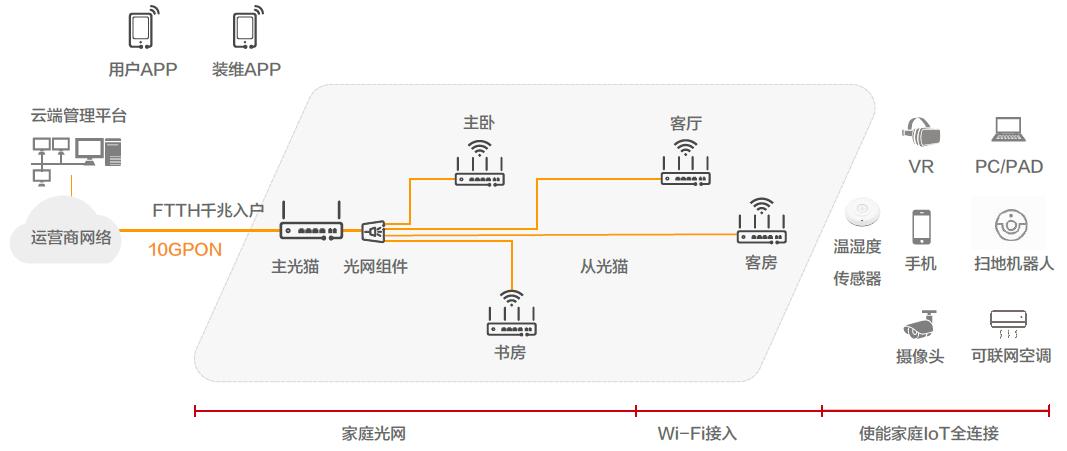FTTR All-optical WiFi
First, before introducing FTTR, we simply understand what FTTx is.
FTTx is the abbreviation for “Fiber To The x” for “fiber to x”, where x not only represents the site where the fiber arrives, but also includes the optical network device installed at the site and identifies the area where the network device serves. For instance, The “B” in FTT B is the abbreviation of Building, refers to the optical fiber to the building, the household optical cable to the corridor, while connected to the user through the twisted pair, the area that the ONU serves is one building or one floor user.
The “H” in FTTH is short for Home, which refers to the optical fiber to the home, the household optical cable to the user’s home, while installed in the user’s home, the area of the ONU serves is one home.
The “R” in FTTR is the abbreviation for Room, which refers to the optical fiber to 2 or more rooms in the user’s home, and installed in the corresponding room, each ONU serves 1 to more rooms in the home.
Second, then why need FTTR, let’s first understand the current user WiFi needs, needs to promote the application.
At present, most home users have WiFi through the ONU / ONT, provided by their own Wifi or connected to a Wifi router, covered by the WiFi signal of the router. The common wifi terminal devices in the market are single frequency and dual frequency. The single frequency only supports 2.4G frequency band. Although it can support the highest rate of 300Mbps, the actual use effect is much worse because the interference of this frequency band is relatively large. Dual-frequency, support for 2.4G and 5G two frequency bands. The 5G WiFi has been improved in rate, but the 5G frequency band WiFi signal’s ability to go through the wall is weak, which brings great inconvenience to some large family types, multi-user families.
At present, there are whole-house WiFi coverage solutions on the market, mainly in the following three categories: the router cascade scheme is to set up the main router at the ONU, each room is set from the router, the master and slave router with CAT6 cable. Limited by the number of master router LAN ports, the number of slave routers generally does not exceed 4, when exceeding, the switch needs to be added at the master router. Due to the use of wired connection, this scheme can guarantee the Gigabit connection between the master and slave routes; the disadvantage is that CAT6 cable need to be arranged in the house, which is difficult to implement, may affect the appearance, and need to automatically switch each equipment WiFi SSID.
Electric ONU are split into wired electric ONU and wireless electric ONU. CAT6 cables are connected to the LAN port of the router; the wireless electric ONU is a wireless router plugged into any power socket in the house (preferably a wall socket), and a wired Electric ONU can be paired with multiple wireless Electric ONU. The signal between the wired Electric ONU and the wireless Electric ONU is transmitted through the power line, and the network speed is greatly affected by the quality of the indoor power line wiring, and the terminal is often easy to drop the line when roaming in each AP.
The subparent routing scheme includes one parent router and multiple subrouters for Mesh networking through WiFi. Because the WiFi signals between the routers are difficult not to go through the wall, the bandwidth capability of this scheme is greatly affected by the environment. There is a child and mother routing product, which uses both WiFi and power line for transmission, which improves the wall penetration ability of WiFi to a certain extent, but the overall bandwidth capability gap is still obvious compared with the router cascade scheme.
Third. Advantages of FTTR
FTTR uses indoor WiFi coverage, master and slave optical cables, FTTR has the following advantages: (1) butterfly optical cable or hidden optical cable compared to CAT6 cable, hidden optical cable does not affect the indoor appearance; (2) the highest network speed near Gigabit users can reach 1000Mbps; (3) stable network speed and smooth terminal switching between ONU; (4) more than 20 years, the bandwidth is almost unlimited.
Due to the above advantages of FTTR, many equipment vendors are currently investing in this area, such as:
Huawei Smart Home =FTTR + Hongmeng
FTTR full optical WiFi, through the perfect collocation of ONU, with optical fiber instead of cable, the gigabit broadband, covering every room of the family, is the connection of the family base, and Hongmeng operating system is all Internet era of intelligent terminal operating system, it can be used in watches, mobile phone, audio, TV and other devices, can also touch connection, Hongmeng FTTR ONU
let large and small terminals in the home, form a super terminal, linkage with each other.
